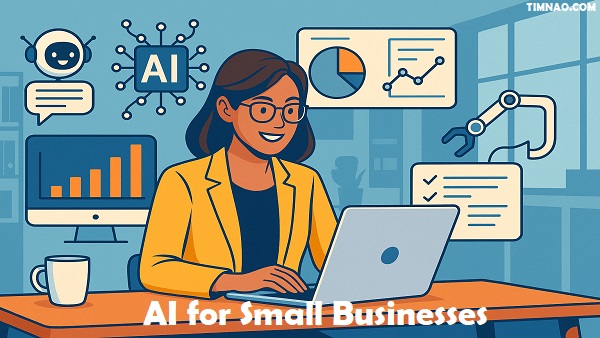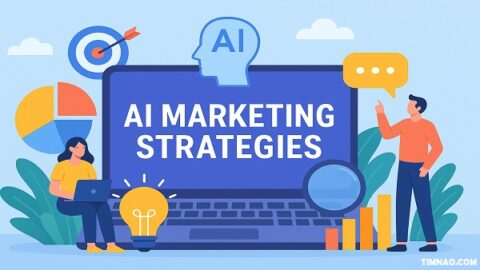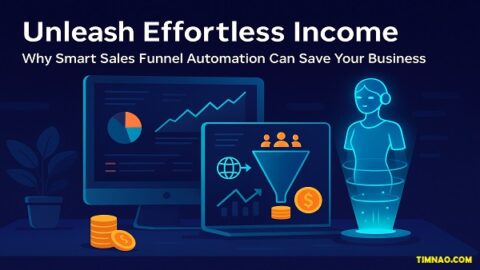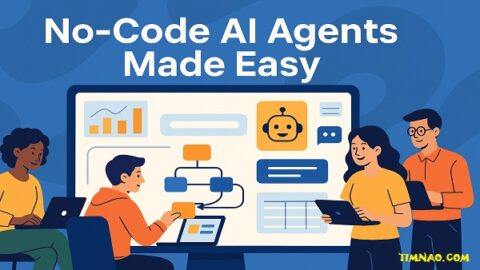Why Most Businesses Fail with AI — And How Smart Ones Use It to Win 🚀
It feels like artificial intelligence is everywhere, doesn’t it? One minute, you’re hearing about self-driving cars; the next, you’re seeing ads for AI-powered apps that promise to triple your productivity overnight. For many entrepreneurs, the hype is both exciting and terrifying. You know you should be using it, but the path forward is foggy. This is where the challenge begins, because successfully implementing AI for small businesses isn’t about buying a fancy tool—it’s about adopting a smarter strategy.
The hard truth is that most businesses, big and small, are fumbling their AI initiatives. They chase shiny objects, invest without a clear plan, and end up with expensive software that gathers digital dust. But a select few are getting it right. They’re not just surviving; they’re thriving, using AI to build moats around their businesses, delight their customers, and operate with staggering efficiency.
What’s their secret? It’s not about having a team of data scientists or a Silicon Valley budget. It’s about understanding the fundamentals, starting small, and focusing on real-world problems. This guide is your roadmap. We’ll break down the jargon, demystify the technology, and give you seven actionable strategies to turn AI from a buzzword into your most powerful competitive advantage in 2025 and beyond.
🧭 Table of Contents
- 🚨 Why Most Businesses Fail at Using AI
- 🚀 How AI Is Quietly Transforming Small Businesses
- 🔎 Data: The Fuel Behind AI’s Magic
- 🧠 Machine Learning Demystified
- 🧰 Real AI Tools and Platforms You Can Start Using Now
- 🛠️ 7 Beginner-Friendly AI Strategies to Implement Today
- 🧭 Common AI Pitfalls — And How to Avoid Them
- 🧑💼 Real-World Case Studies: What Success Looks Like
- 🔒 Ethics, Trust & AI: What You Absolutely Must Know
- 🧩 Final Thoughts: Build an AI-Powered Business with Confidence
🚨 Why Most Businesses Fail at Using AI
Before we dive into the winning playbook, let’s look at the fumbles. Why do so many well-intentioned AI projects end in failure? It usually comes down to a few common, avoidable mistakes. Understanding these traps is the first step toward sidestepping them entirely.
First and foremost is the “solution in search of a problem” syndrome. A business owner hears about a revolutionary AI chatbot and immediately thinks, “I need one!” without first asking why. What specific problem will it solve? Will it reduce customer service tickets, increase lead generation, or handle after-hours inquiries? Without a clear business case, the shiny new tool becomes a costly distraction. The consequence? Wasted time, money, and a growing skepticism toward AI.
Another major hurdle is a lack of clean, relevant data. We’ll cover this in detail soon, but AI is not magic; it’s data-driven. If you feed an algorithm messy, incomplete, or biased information (the digital equivalent of junk food), you’ll get unreliable and useless results. Many businesses dive in without a data strategy, only to realize their most valuable asset is a chaotic mess spread across a dozen incompatible spreadsheets and platforms.
Finally, there’s the fear of complexity and the expectation of instant results. AI is not a single “on” switch. It’s a journey of experimentation, learning, and gradual integration. Business leaders who expect an AI tool to triple revenue in the first quarter are setting themselves up for disappointment. True artificial intelligence strategies involve a cultural shift—a commitment to testing, measuring, and iterating over time. Success is incremental, not instantaneous.
🚀 How AI Is Quietly Transforming Small Businesses
While some stumble, others are making incredible strides. The beauty of modern AI is its accessibility. You no longer need to be a tech giant to leverage its power. Here are a few examples of how small businesses are winning with AI today:
- For Retail & E-commerce Shops: An online boutique uses an AI-powered recommendation engine (like the one built into Shopify) to analyze a customer’s Browse history and past purchases. It then suggests products they are highly likely to love, dramatically increasing the average order value and customer loyalty.
- For Service-Based Businesses: A local plumbing company implements an AI scheduling tool like Calendly or Acuity Scheduling. This tool not only automates appointment booking 24/7 but also sends intelligent reminders, drastically reducing no-shows and freeing up administrative staff to focus on customer relationships and dispatching.
- For Local Restaurants: A family-owned restaurant uses an AI-driven inventory management system. This system analyzes sales data from its POS, predicts demand for certain dishes based on day of the week, weather, and local events, and then suggests precise ingredient orders. The result is significantly less food waste and improved profitability.
- For Healthcare Clinics: A small dental practice uses an AI-powered transcription service like DeepScribe to automatically document patient visits. This frees up the dentist and hygienists from tedious note-taking, allowing them to focus entirely on patient care, improving both the patient experience and clinical efficiency.
- For Content Creators & Marketers: A solo marketing consultant uses AI writing assistants like Jasper or Copy.ai to brainstorm blog post ideas, draft social media captions, and create email marketing sequences. This allows them to produce high-quality content at scale, competing with much larger agencies.
🔎 Data: The Fuel Behind AI’s Magic
Think of AI as a brilliant chef. You can have the most advanced kitchen in the world, but without high-quality ingredients, the meal will be a disaster. In the world of AI, data is the ingredients. The success of any AI for small businesses hinges on the quality and relevance of its data.
Quantity vs. Quality: What Really Matters?
It’s a common misconception that you need massive, “big data” level datasets to get started with AI. While more data is often better, quality trumps quantity every time. A small, clean, and well-organized dataset of 1,000 customers is infinitely more valuable than a messy, incomplete list of 100,000 leads.
- Quality Data: Is accurate, complete, consistent, and relevant to the problem you’re solving.
- Junk Data: Contains duplicates, missing fields, outdated information, and inconsistencies.
Best Practices for Collecting and Managing Business Data
You’re likely already sitting on a goldmine of data. The key is to organize it.
- Centralize Your Data: The first step is to break down data silos. Instead of having customer information in your email marketing tool, payment processor, and a separate spreadsheet, use a central hub. This is where a Customer Relationship Management (CRM) system comes in.
- Standardize Your Inputs: Ensure that data is entered consistently. For example, use a dropdown menu for “State” instead of a free-text field to avoid variations like “CA,” “Calif.,” and “California.”
- Regularly Cleanse Your Data: Set aside time each quarter to review your data for duplicates, outdated contacts, and incomplete records. There are tools that can help automate this process.
Beginner Tools for Data Management:
- HubSpot Free CRM: An excellent starting point for centralizing customer contacts, tracking interactions, and managing your sales pipeline.
- Shopify Analytics: If you run an e-commerce store on Shopify, its built-in analytics provide a wealth of information on sales, customer behavior, and marketing effectiveness.
- Google Analytics 4 (GA4): Essential for understanding your website traffic. It tells you who your visitors are, how they found you, and what they do on your site.
- Segment: A more advanced (but incredibly powerful) tool that acts as a central nervous system for your customer data. It collects data from all your different tools (website, app, payment system) and sends it wherever you need it, ensuring consistency everywhere.
🧠 Machine Learning Demystified
“Machine Learning” (ML) sounds intimidating, but it’s the core engine behind most of the AI tools you’ll use. It’s simply the process of teaching a computer to recognize patterns in data and then make predictions or decisions without being explicitly programmed for every single scenario.
Let’s break down the main types with easy-to-understand analogies.
1. Supervised Learning
- Analogy: Think of it like teaching a child with flashcards. You show them a picture of a cat and say “cat.” You show them a picture of a dog and say “dog.” After seeing enough examples, they learn to identify cats and dogs on their own.
- How it Works: You feed the algorithm labeled data (input + correct output). The AI learns the relationship between the two.
- Business Use Case: Spam filtering. The AI is trained on thousands of emails that have been labeled “spam” or “not spam.” It learns the characteristics of junk mail (certain keywords, sender reputation, etc.) and then automatically filters your inbox. Another example is predicting customer churn based on past customers who have been labeled “churned” or “active.”
2. Unsupervised Learning
- Analogy: Imagine giving that same child a box of mixed Lego bricks and asking them to sort them. Without any instructions, they’ll likely start grouping the bricks by color, size, or shape. They are finding patterns on their own.
- How it Works: You give the algorithm unlabeled data and it identifies hidden patterns, structures, and clusters within it.
- Business Use Case: Customer segmentation. An unsupervised algorithm can analyze your customer base and automatically group them into segments based on purchasing behavior, demographics, or engagement levels—clusters you might never have discovered on your own. For example, it might identify a “high-value, low-frequency” group that could be targeted with a loyalty program.
3. Reinforcement Learning
- Analogy: This is like training a dog. When it performs a trick correctly (like “sit”), you give it a treat (a reward). When it does something wrong, it gets no treat. Over time, it learns the actions that maximize its rewards.
- How it Works: The AI (or “agent”) learns by interacting with an environment. It takes actions, receives rewards or penalties, and adjusts its strategy to achieve a specific goal.
- Business Use Case: Dynamic pricing. An e-commerce site can use reinforcement learning to adjust product prices in real-time. If it raises the price slightly and sales continue, it gets a “reward.” If sales drop, it gets a “penalty.” Over time, it learns the optimal price point that maximizes revenue.
🧰 Real AI Tools and Platforms You Can Start Using Now
Getting started with AI doesn’t require a degree in computer science. There are hundreds of powerful, user-friendly tools designed for business owners. Here are five beginner-friendly options you can explore this week.
| Tool Name | Primary Use Case | Best For | Website |
| Jasper.ai | AI Content Creation | Marketers, bloggers, and business owners who need to create high-quality copy for ads, emails, and websites quickly. | jasper.ai |
| Tidio | AI-Powered Customer Service | Small businesses looking to offer 24/7 customer support, capture leads, and automate answers to common questions via chatbots. | tidio.com |
| Flick | Social Media Management | Entrepreneurs and social media managers who want AI-powered help with content brainstorming, hashtag strategy, and scheduling. | flick.tech |
| Timely | Automated Time Tracking | Freelancers, agencies, and consultants who need to accurately track time spent on different projects and clients without manual start/stop timers. | timelyapp.com |
| Beautiful.ai | AI Presentation Design | Anyone who needs to create stunning, professional presentations quickly without fussing over alignment, fonts, and layouts. | beautiful.ai |
🛠️ 7 Beginner-Friendly AI Strategies to Implement Today
Now for the core of our guide: actionable artificial intelligence strategies. Don’t try to implement all of these at once. Pick one that addresses your biggest pain point and start there.
Strategy 1: Hyper-Personalize Your Email Marketing
- What it is: Using AI to move beyond “Hi [First Name]” and send emails that are uniquely relevant to each subscriber based on their behavior.
- Why it matters: Personalized emails deliver 6x higher transaction rates, but 70% of brands fail to use them. This is a massive opportunity to stand out.
- How to do it:
- Choose the Right Tool: Select an email marketing platform with built-in AI and automation features.
- Integrate Your Data: Connect your e-commerce store (e.g., Shopify) or website to your email platform so it can track purchases, Browse history, and abandoned carts.
- Set Up Behavioral Triggers: Create automated email sequences that are triggered by specific actions. For example:
- Abandoned Cart: If a user leaves items in their cart, automatically send a reminder email 1 hour later, perhaps with a small discount.
- Product Recommendation: After a customer makes a purchase, send a follow-up email a week later recommending related products.
- Welcome Series: When someone new subscribes, send a series of 3-5 emails that introduce your brand, showcase your best products, and offer a newcomer discount.
- What tools to use: Klaviyo (excellent for e-commerce), MailerLite (great for beginners with powerful automation), ActiveCampaign (advanced CRM and email automation).
- What result to expect: Higher email open rates, increased click-through rates, more sales from email, and a significant reduction in abandoned carts.
Strategy 2: Automate Customer Service with an AI Chatbot
- What it is: Deploying a smart chatbot on your website to answer common questions, qualify leads, and assist customers 24/7.
- Why it matters: It frees up your team from repetitive inquiries (e.g., “What are your business hours?”) and provides instant support to visitors, improving their experience and capturing leads you might otherwise miss.
- How to do it:
- Identify FAQs: List the top 10-15 questions your customers ask most frequently.
- Choose a Chatbot Platform: Select a user-friendly platform that requires no coding.
- Build Conversation Flows: Use a drag-and-drop editor to design the chatbot’s conversations. Start with your FAQs. For example: If a user asks about “shipping,” the bot can provide a link to your shipping policy page.
- Define a Handover Protocol: Decide when the bot should hand the conversation over to a human agent (e.g., if the user asks a complex question or types “talk to a person”).
- Install and Train: Add the chatbot to your website (usually a simple copy-paste script) and monitor the initial conversations to see where it can be improved.
- What tools to use: Tidio, Intercom, Drift (more for B2B sales).
- What result to expect: A 30%+ reduction in repetitive customer service tickets, lead generation even after business hours, and higher customer satisfaction scores.
Strategy 3: Optimize Your Social Media Strategy
- What it is: Using AI to analyze what content resonates with your audience, find the best times to post, and discover effective hashtags.
- Why it matters: Stop guessing what works on social media. AI can give you data-backed insights to grow your following and engagement much faster.
- How to do it:
- Connect Your Accounts: Sign up for an AI-powered social media tool and connect your Instagram, Facebook, TikTok, etc.
- Analyze Your Performance: Use the tool’s analytics to see which of your past posts got the most likes, comments, and shares. The AI will often surface patterns you missed.
- Leverage AI Suggestions: Use the AI to generate content ideas, suggest relevant and trending hashtags for your niche, and recommend the optimal times to post based on when your specific audience is most active.
- Schedule Your Content: Plan your content calendar within the tool and let it post automatically at the optimal times.
- What tools to use: Flick, Later, Buffer.
- What result to expect: Increased reach and engagement on your posts, steady follower growth, and hours saved each week on social media management.
Strategy 4: Generate High-Quality Content at Scale
- What it is: Using Generative AI tools to brainstorm, draft, and refine written content like blog posts, ad copy, and product descriptions.
- Why it matters: Content is king, but it’s incredibly time-consuming to create. AI acts as a creative partner, helping you overcome writer’s block and produce more content without sacrificing quality.
- How to do it:
- Choose a Generative AI Writer: Select a tool that fits your needs.
- Master the Art of the Prompt: The quality of your AI-generated content depends entirely on the quality of your instructions (“prompts”). Be specific. Instead of “Write a blog post about coffee,” try “Write a 1000-word blog post about the benefits of single-origin coffee for home brewers, with a friendly and knowledgeable tone.”
- Use AI for Ideation and Drafting: Use the tool to brainstorm titles, create outlines, and write the first draft.
- Edit and Humanize: This is the critical step. Never copy and paste directly. Always review, edit, and add your own unique voice, stories, and insights. The AI provides the foundation; you provide the soul.
- What tools to use: Jasper.ai, Copy.ai, ChatGPT.
- What result to expect: A dramatic increase in your content output, the ability to overcome writer’s block, and more time to focus on strategy rather than just writing.
Strategy 5: Uncover Insights with Predictive Analytics
- What it is: Using AI to analyze your past business data to forecast future trends, such as sales, customer demand, or inventory needs.
- Why it matters: This moves you from reactive to proactive decision-making. Instead of running out of your best-selling product, you can anticipate demand and order the right amount in advance.
- How to do it:
- Consolidate Your Sales Data: Ensure your historical sales data is clean and accessible (e.g., in your Shopify store, QuickBooks, or a spreadsheet).
- Use an AI-Powered Analytics Tool: Many modern e-commerce and accounting platforms have predictive analytics built-in.
- Generate a Forecast: Run a report to forecast sales for the next month or quarter. The AI will analyze past sales, seasonality, and growth trends.
- Make Data-Driven Decisions: Use the forecast to inform your inventory orders, marketing campaigns, and staffing schedules.
- What tools to use: Shopify Analytics (has predictive features), QuickBooks Online Advanced (offers cash flow forecasting), specialized inventory tools like Inventory Planner.
- What result to expect: Reduced stockouts and overstock situations, improved cash flow management, and more profitable marketing campaigns.
Strategy 6: Streamline Your Hiring Process
- What it is: Using AI to automate the tedious parts of recruitment, from screening resumes to scheduling interviews.
- Why it matters: Hiring is time-consuming and expensive. AI can help you find the right candidates faster and reduce unconscious bias in the screening process.
- How to do it:
- Write Clear Job Descriptions: Be very clear about the skills and qualifications required. This helps the AI screen effectively.
- Use an Applicant Tracking System (ATS) with AI: When you post a job, the ATS will collect all applications.
- Let AI Screen Resumes: The AI can scan hundreds of resumes in minutes, ranking candidates based on how well their skills and experience match the job description.
- Automate Interview Scheduling: Once you have a shortlist, use an AI scheduling tool to find a time that works for everyone, eliminating the back-and-forth emails.
- What tools to use: Freshteam, Zoho Recruit, Manatal.
- What result to expect: A significantly faster time-to-hire, a more diverse candidate pool, and many hours of administrative work saved.
Strategy 7: Enhance Your Cybersecurity
- What it is: Using AI-driven tools to proactively monitor your business’s digital assets and protect against cyber threats like malware and phishing attacks.
- Why it matters: A single cyberattack can be devastating for a small business. AI provides a level of vigilance that is impossible to achieve manually.
- How to do it:
- Choose an AI-Powered Security Solution: Select an antivirus or endpoint security software that uses machine learning to detect threats.
- Enable Behavioral Threat Detection: Traditional antivirus looks for known threats. AI-powered security looks for unusual behavior. For example, it can flag if a program suddenly tries to encrypt all your files, even if it’s a brand new type of ransomware.
- Use Smart Email Filtering: Implement an email security gateway that uses AI to analyze incoming emails for signs of phishing, spoofing, or malicious attachments.
- What tools to use: CrowdStrike, SentinelOne, AI-enhanced features within Microsoft Defender and Google Workspace.
- What result to expect: Greatly reduced risk of a successful cyberattack, protection against new and unknown “zero-day” threats, and peace of mind.
🧭 Common AI Pitfalls — And How to Avoid Them
As you embark on your AI journey, you’ll likely encounter some common roadblocks. Here’s how to navigate them.
- Challenge: “I don’t have enough data.”
- Solution: Start with what you have. Even small amounts of data from your website analytics, sales records, or social media can be valuable. Focus on strategies that don’t require massive datasets, like using AI content writers or customer service chatbots. Your goal is to start collecting clean data now so you can use it for more advanced applications later.
- Challenge: “AI tools are too expensive.”
- Solution: This is a myth in 2025. Many powerful AI tools operate on a “freemium” model, offering a robust free plan that is perfect for small businesses (e.g., HubSpot CRM, Tidio’s free chatbot, MailerLite). Start with free tools, prove their value, and only upgrade when the ROI is clear.
- Challenge: “I’m not technical enough to implement this.”
- Solution: The modern AI landscape is dominated by “no-code” and “low-code” platforms. The tools listed in this guide are designed for business users, not developers. They feature intuitive interfaces, drag-and-drop editors, and excellent customer support. Start with one tool and watch a few tutorial videos; you’ll be surprised how quickly you can master it.
- Challenge: “I’m worried AI will replace my employees.”
- Solution: Reframe your thinking. The goal of AI for small businesses is not replacement, but augmentation. AI should handle the repetitive, tedious, and data-heavy tasks, freeing up your human team to focus on what they do best: strategy, creativity, building customer relationships, and complex problem-solving. It’s a partnership, not a competition.
🧑💼 Real-World Case Studies: What Success Looks Like
Looking at how bigger companies have succeeded can provide powerful lessons for small businesses.
1. Stitch Fix: The Power of Personalization
- Before AI: Stitch Fix was an online styling service, but its initial recommendations were largely manual, relying on stylists Browse through inventory. It was difficult to scale personalization.
- The AI Transformation: The company built a powerful AI engine that combines customer data (style quizzes, feedback, Pinterest boards) with product data (attributes for every clothing item). This AI provides stylists with hyper-relevant recommendations for each client.
- What Worked: They didn’t replace their human stylists. They empowered them. The AI does the heavy lifting of data analysis, while the human stylist makes the final creative choice. This human-in-the-loop system is their secret sauce.
- The Lesson for Small Businesses: You can do this on a smaller scale. Use a tool like Klaviyo to analyze customer data and create personalized email campaigns. The AI provides the segments and recommendations; you write the engaging copy.
2. Coca-Cola: Predicting Future Success
- Before AI: Coca-Cola, like many beverage companies, relied on traditional market research and focus groups to launch new flavors—a slow and often inaccurate process.
- The AI Transformation: Before launching its “Sprite Cherry” flavor, Coca-Cola used AI to analyze vast amounts of data from self-service soda fountains. These machines allowed customers to mix their own drink combinations. The AI identified that a surprising number of people were adding cherry flavor to Sprite.
- What Worked: They used real-world behavioral data, not just survey opinions, to validate a new product idea before a major investment.
- The Lesson for Small Businesses: You have data like this too! Analyze your website search queries. What are people looking for that you don’t offer? Analyze your chatbot logs. What questions are people asking over and over? This data is a goldmine for product and service ideas.
3. P&G: Optimizing Marketing Spend
- Before AI: Procter & Gamble (P&G), a consumer goods giant, spent billions on advertising across countless channels, but it was difficult to measure the precise ROI of each campaign.
- The AI Transformation: P&G developed an AI platform to analyze consumer data and create “propensity models.” These models predict which consumers are most likely to buy a certain product (e.g., Tide Pods) and which advertising channels are most effective at reaching them.
- What Worked: Instead of a broad, “spray and pray” approach, they used AI to target their advertising with surgical precision, reaching the right customers on the right platforms. This allowed them to cut marketing spend while increasing its effectiveness.
- The Lesson for Small Businesses: This is exactly what tools like Facebook Ads and Google Ads allow you to do. By installing a tracking pixel on your site, you feed their AI data about your customers. You can then create “lookalike audiences” to find new customers who are just like your existing best ones, optimizing your ad spend automatically.
🔒 Ethics, Trust & AI: What You Absolutely Must Know
Using AI comes with great power, and therefore, great responsibility. Ignoring the ethical implications isn’t just bad practice; it can damage your reputation and lead to legal trouble.
Bias in AI
AI learns from the data it’s given. If that data reflects historical biases, the AI will learn and perpetuate them. For example, if an AI hiring tool is trained on data from a company that historically only hired men for technical roles, it may learn to penalize resumes from women.
- How to Stay Compliant: Be mindful of your data sources. Regularly audit the outcomes of your AI systems. Is your AI chatbot treating all customers with respect? Is your hiring tool giving you a diverse slate of candidates? Always have a human in the loop for critical decisions.
Transparency and Explainable AI
Your customers have a right to know when they are interacting with an AI and how their data is being used. Don’t hide the fact that your chatbot is a bot. Explainable AI (XAI) is a growing field focused on building systems that can explain why they made a particular decision. While complex, the principle is simple: be transparent.
- How to Stay Compliant: Have a clear and easy-to-understand privacy policy. In your chatbot, include a message like, “Hi, I’m [Your Brand]’s friendly AI assistant!” Be prepared to explain to a customer why they received a particular product recommendation.
Data Privacy Laws (GDPR/CCPA)
Regulations like Europe’s GDPR (General Data Protection Regulation) and California’s CCPA (California Consumer Privacy Act) grant consumers rights over their data, including the right to access, edit, and delete it.
- How to Stay Compliant: Use reputable software platforms that are GDPR/CCPA compliant. Ensure you have clear consent mechanisms (e.g., cookie banners, email opt-ins). And if a customer asks you to delete their data, have a process in place to do so promptly and completely. Building trust is paramount.
🧩 Final Thoughts: Build an AI-Powered Business with Confidence
We’ve covered a lot of ground, from the high-level strategy of AI for small businesses to the nitty-gritty of specific tools and tactics. If there’s one thing to take away from this guide, it’s this: AI is a journey, not a destination.
You don’t need to become an AI expert overnight. You just need to become a strategic thinker who is willing to start small, experiment, and learn. Forget the dystopian fears of robot takeovers. The future belongs to businesses that master the human-AI partnership—where technology handles the grunt work, and humans provide the vision, empathy, and creativity.
Pick one challenge in your business right now. Is it customer service? Content creation? Inventory management? Find a simple, beginner-friendly AI tool and commit to trying it for one month. Measure the results. Learn from the process. That first small step is the most important one you’ll take. By embracing a mindset of continuous improvement, you can build a smarter, more efficient, and more resilient business that is ready to win in 2025 and for years to come.









